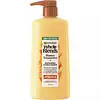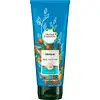What's inside
What's inside
 Key Ingredients
Key Ingredients

No key ingredients
 Benefits
Benefits

 Concerns
Concerns

 Ingredients Side-by-side
Ingredients Side-by-side

Water
Skin ConditioningCetearyl Alcohol
EmollientBehentrimonium Chloride
PreservativeAmodimethicone
Honey
HumectantArgania Spinosa Kernel Oil
EmollientPotassium Hydroxide
BufferingRoyal Jelly
Glycerin
HumectantTrideceth-6
EmulsifyingAloe Barbadensis Leaf Juice
Skin ConditioningAlcohol
AntimicrobialPropolis Extract
Skin ConditioningIsopropyl Alcohol
SolventCitric Acid
BufferingPhenoxyethanol
PreservativeCetrimonium Chloride
AntimicrobialBenzoic Acid
MaskingCI 15985
Cosmetic ColorantCI 19140
Cosmetic ColorantParfum
MaskingCoumarin
PerfumingLimonene
PerfumingBenzyl Alcohol
PerfumingBenzyl Salicylate
PerfumingFish Oil
Skin ConditioningCeramide AP
Skin ConditioningWater, Cetearyl Alcohol, Behentrimonium Chloride, Amodimethicone, Honey, Argania Spinosa Kernel Oil, Potassium Hydroxide, Royal Jelly, Glycerin, Trideceth-6, Aloe Barbadensis Leaf Juice, Alcohol, Propolis Extract, Isopropyl Alcohol, Citric Acid, Phenoxyethanol, Cetrimonium Chloride, Benzoic Acid, CI 15985, CI 19140, Parfum, Coumarin, Limonene, Benzyl Alcohol, Benzyl Salicylate, Fish Oil, Ceramide AP
Water
Skin ConditioningStearyl Alcohol
EmollientBehentrimonium Methosulfate
Bis-Aminopropyl Dimethicone
Cetyl Alcohol
EmollientOleic Acid
EmollientParfum
MaskingBenzyl Alcohol
PerfumingDicetyldimonium Chloride
EmulsifyingIsopropyl Alcohol
SolventSodium Benzoate
MaskingPropylene Glycol
HumectantDisodium EDTA
Benzyl Benzoate
AntimicrobialHexyl Cinnamal
PerfumingHistidine
HumectantCitric Acid
BufferingButylene Glycol
HumectantArgania Spinosa Kernel Oil
EmollientAloe Barbadensis Leaf Juice
Skin ConditioningAlcohol Denat.
AntimicrobialEcklonia Radiata Extract
Skin ConditioningWater, Stearyl Alcohol, Behentrimonium Methosulfate, Bis-Aminopropyl Dimethicone, Cetyl Alcohol, Oleic Acid, Parfum, Benzyl Alcohol, Dicetyldimonium Chloride, Isopropyl Alcohol, Sodium Benzoate, Propylene Glycol, Disodium EDTA, Benzyl Benzoate, Hexyl Cinnamal, Histidine, Citric Acid, Butylene Glycol, Argania Spinosa Kernel Oil, Aloe Barbadensis Leaf Juice, Alcohol Denat., Ecklonia Radiata Extract
 Reviews
Reviews

Ingredients Explained
These ingredients are found in both products.
Ingredients higher up in an ingredient list are typically present in a larger amount.
Aloe Barbadensis Leaf Juice comes from leaves of the aloe plant. Aloe Barbadensis Leaf Juice is best known for helping to soothe sunburns. It is also anti-inflammatory, moisturizing, antiseptic, and can help heal wounds.
Aloe is packed with good stuff including Vitamins A, C, and E. These vitamins are antioxidants, which help fight free-radicals and the damage they may cause. Free-radicals are molecules that may damage your skin cells, such as pollution.
Aloe Barbadensis Leaf Juice also contains sugars. These sugars come in the form of monosaccharides and polysaccharides, folic acid, and choline. These sugars are able to help bind moisture to skin.
It also contains minerals such as calcium, 12 anthraquinones, fatty acids, amino acids, and Vitamin B12.
Learn more about Aloe Barbadensis Leaf JuiceYou may know this ingredient as argan oil. Argan Oil has antioxidant, hydrating, and soothing properties.
Studies have shown argan oil can help fight again radical damage from the sun. This makes it effective at preventing hyperpigmentation.
Large amounts of vitamin E found in argan oil helps the skin retain water. Argan oil also contains fatty acids such as linoleic acid, oleic acid, and palmitic acid. It is also a good source of lipids.
Another benefit of argan oil is skin-soothing. It can help reduce inflammation-related skin symptoms.
Argan Oil is effective at regulating sebum production in pores. This can make it effective at treating hormonal acne.
Traditionally, argan oil was used for its antibacterial and antifungal properties. However, argan oil contains fatty acids that may make it not fungal-acne safe.
Argan Trees are native to Morocco.
Learn more about Argania Spinosa Kernel OilBenzyl Alcohol is most commonly used as a preservative. It also has a subtle, sweet smell. Small amounts of Benzyl Alcohol is not irritating and safe to use in skincare products. Most Benzyl Alcohol is derived from fruits such as apricots.
Benzyl Alcohol has both antibacterial and antioxidant properties. These properties help lengthen the shelf life of products. Benzyl Alcohol is a solvent and helps dissolve other ingredients. It can also improve the texture and spreadability.
Alcohol comes in many different forms. Different types of alcohol will have different effects on skin. This ingredient is an astringent alcohol.
Using high concentrations of these alcohols are drying on the skin. They may strip away your skin's natural oils and even damage your skin barrier. Astringent alcohols may also irritate skin.
Other types of astringent alcohols include:
According to the National Rosacea Society based in the US, you should be mindful of products with these alcohols in the top half of ingredients.
Any type of sanitizing product will have high amounts of alcohol to help kill bacteria and viruses.
Learn more about Benzyl AlcoholCitric Acid is an alpha hydroxy acid (AHA) naturally found in citrus fruits like oranges, lemons, and limes.
Like other AHAs, citric acid can exfoliate skin by breaking down the bonds that hold dead skin cells together. This helps reveal smoother and brighter skin underneath.
However, this exfoliating effect only happens at high concentrations (20%) which can be hard to find in cosmetic products.
Due to this, citric acid is usually included in small amounts as a pH adjuster. This helps keep products slightly more acidic and compatible with skin's natural pH.
In skincare formulas, citric acid can:
While it can provide some skin benefits, research shows lactic acid and glycolic acid are generally more effective and less irritating exfoliants.
Most citric acid used in skincare today is made by fermenting sugars (usually from molasses). This synthetic version is identical to the natural citrus form but easier to stabilize and use in formulations.
Read more about some other popular AHA's here:
Learn more about Citric AcidIsopropyl Alcohol is more commonly known as rubbing alcohol. It is most commonly used as a solvent, meaning it helps other ingredients dissolve.
This ingredient is an astringent alcohol. Astringent alcohols may also irritate skin as they high amounts may strip away your skin's natural oils.
Other types of astringent alcohols include:
According to the National Rosacea Society based in the US, you should be mindful of products with these alcohols in the top half of ingredients.
Any type of sanitizing product will have high amounts of alcohol to help kill bacteria and viruses.
Learn more about Isopropyl AlcoholParfum is a catch-all term for an ingredient or more that is used to give a scent to products.
Also called "fragrance", this ingredient can be a blend of hundreds of chemicals or plant oils. This means every product with "fragrance" or "parfum" in the ingredients list is a different mixture.
For instance, Habanolide is a proprietary trade name for a specific aroma chemical. When used as a fragrance ingredient in cosmetics, most aroma chemicals fall under the broad labeling category of “FRAGRANCE” or “PARFUM” according to EU and US regulations.
The term 'parfum' or 'fragrance' is not regulated in many countries. In many cases, it is up to the brand to define this term.
For instance, many brands choose to label themselves as "fragrance-free" because they are not using synthetic fragrances. However, their products may still contain ingredients such as essential oils that are considered a fragrance by INCI standards.
One example is Calendula flower extract. Calendula is an essential oil that still imparts a scent or 'fragrance'.
Depending on the blend, the ingredients in the mixture can cause allergies and sensitivities on the skin. Some ingredients that are known EU allergens include linalool and citronellol.
Parfum can also be used to mask or cover an unpleasant scent.
The bottom line is: not all fragrances/parfum/ingredients are created equally. If you are worried about fragrances, we recommend taking a closer look at an ingredient. And of course, we always recommend speaking with a professional.
Learn more about ParfumWater. It's the most common cosmetic ingredient of all. You'll usually see it at the top of ingredient lists, meaning that it makes up the largest part of the product.
So why is it so popular? Water most often acts as a solvent - this means that it helps dissolve other ingredients into the formulation.
You'll also recognize water as that liquid we all need to stay alive. If you see this, drink a glass of water. Stay hydrated!
Learn more about Water